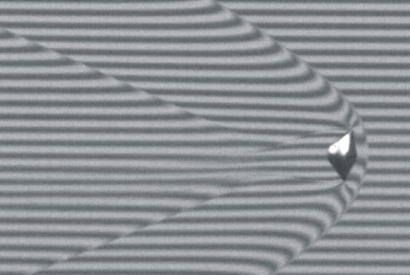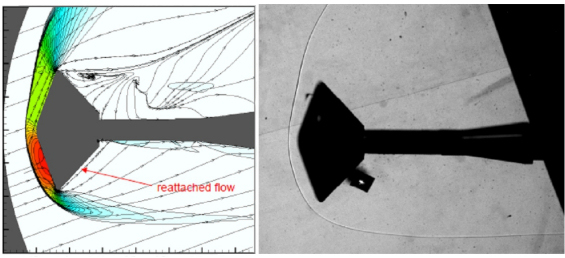EDM Aerothermodynamic Tests
The EDM will reach the Martian atmosphere at a velocity of 5.83 kilometres per second (Mach 30) and will decelerate within roughly 3 minutes to 450 metres per second (above Mach 2), under aerodynamic drag. This deceleration is severe, of the order of 10 times acceleration due to Earth's gravity, and will heat the external side of the EDM.
To fly safely through this hostile environment, the EDM must be highly stable, as any uncontrolled oscillation could lead to the loss of the Module.
A test campaign has been performed at the most advanced facilities in Europe to accurately determine the aerothermodynamics conditions during Entry Descent and Landing (EDL). The tests were carried out at two types of aerothermodynamics facilities: wind tunnels and ballistic ranges. Both facilities allow testing only on scale models.
 |
| View of the EDM model in the S4MA wind tunnel of ONERA. Credit: ONERA |
 |
| Free-flight field test at supersonic speeds. Credit: Institut Saint-Louis |
Wind tunnels generate a controlled gas flow around a static scaled model of the vehicle. Different wind tunnel designs allow a large variety of gas velocities and compositions to be generated. Air is the most commonly used gas, but tests in carbon dioxide are necessary to replicate the Martian atmosphere. The wind tunnels offer the advantage of a controlled environment and allow easy repetition of tests but the equipment necessary to affix the model in the tunnel firmly may introduce significant disturbances into the measurements.
To avoid this, tests at a ballistic range, using a method similar to the actual flight of the vehicle was employed. A powder gun launches the model so as to reach the required velocity. It then undergoes free flight in a test field or in an indoor facility. However, the velocity that the model reaches under these conditions is limited (less than Mach 3 for the EDM tests, roughly 1.02 kilometres per second), and this test method does not allow highly controlled and repetitive testing.
The aerothermodynamics test campaigns aimed to answer key questions related to entry and descent of the EDM in the Martian atmosphere:
- The heat flux distribution on the front and back sides of the EDM at the hottest point during entry was measured during high enthalpy plasma tests in the French Aerospace Lab (ONERA) F4 hypersonic wind tunnel and the German-Dutch Wind Tunnels High-enthalpy shock-tunnel at Göttingen (DNW/DLR HEG). The tests were completed at the end of 2009.
Testing in the high-enthalpy shock tunnel at Göttingen.
Credit: DLR
Click here for more information on this video - The heat flux increase on the EDM due to turbulence was determined by a series of test campaigns. Turbulence tests were completed successfully in late 2008 at the DNW/DLR TMK and H2K wind tunnels, and roughness characterisation tests were performed until mid-2011 at the University of Manchester and DNW/DLR wind tunnels.
- The aerodynamic forces acting on the EDM at high velocity were estimated during the hypersonic cold tests in the ONERA S4 Wind Tunnel. These tests were completed early in 2009.
- The stability of the EDM while crossing transonic speeds (when the EDM velocity is close to the speed of sound) was assessed during the open-range ballistic supersonic-transonic tests at the Institut Saint-Louis (ISL) and in free oscillation tests at transonic speeds at the DNW/DLR Trisonic Test Section Cologne (TMK) Wind Tunnel. These tests determined the capability of the EDM to go through the low supersonic regime without major instability, and were completed in late 2009.
Open-range ballistic tests at the Institut Saint-Louis.
Credit: Institut Saint-Louis
Click here for more information on this video - The aerodynamic forces acting on the EDM at low speeds, during the separation of the front shield in particular, were measured during the subsonic tests in DNW/NLR Transonic Wind Tunnel (HST). These tests were completed late in 2009.
The Aerothermodynamic test activities were carried out by European industry, led by Thales Alenia Space, Italy and Fluid Gravity Engineering, including key contributions from EADS Astrium, DLR, ONERA, ISL and DNW, under the close supervision of ESA.


